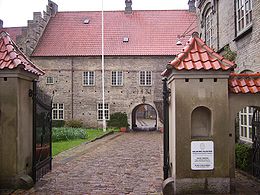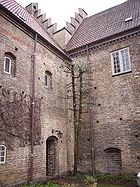
Hospital of the Holy Ghost, Aalborg
Encyclopedia


Order of the Holy Ghost
The order was responsible for running hospitals - Hospitals of the Holy Ghost - throughout Europe for centuries, and in its heyday the number of its houses ran into many hundreds...
in Aalborg
Aalborg
-Transport:On the north side of the Limfjord is Nørresundby, which is connected to Aalborg by a road bridge Limfjordsbroen, an iron railway bridge Jernbanebroen over Limfjorden, as well as a motorway tunnel running under the Limfjord Limfjordstunnelen....
, Denmark
Denmark
Denmark is a Scandinavian country in Northern Europe. The countries of Denmark and Greenland, as well as the Faroe Islands, constitute the Kingdom of Denmark . It is the southernmost of the Nordic countries, southwest of Sweden and south of Norway, and bordered to the south by Germany. Denmark...
. It was the hospital of Aalborg from 1431 to 1953 and is one of Denmark's best preserved medieval establishments. These are the oldest buildings in north Jutland
Jutland
Jutland , historically also called Cimbria, is the name of the peninsula that juts out in Northern Europe toward the rest of Scandinavia, forming the mainland part of Denmark. It has the North Sea to its west, Kattegat and Skagerrak to its north, the Baltic Sea to its east, and the Danish–German...
, and the former hospital is also the oldest social institution in Denmark.
Foundation
The hospital was founded in 1431 by the wealthy Lady Maren Hemmingsdatter with the gift of a large house, adjoining land and an endowment as a "House of the Holy Ghost" , common in Denmark at that period, a charitable institution of a religious nature for the care of the sick, old and poor. In 1434 the house burnt down and the present buildings were built to replace it.Order of the Holy Ghost
On 20 August 1451 it formally became a part of the Order of the Holy GhostOrder of the Holy Ghost
The order was responsible for running hospitals - Hospitals of the Holy Ghost - throughout Europe for centuries, and in its heyday the number of its houses ran into many hundreds...
, a hospitaller order which had originated in Montpellier
Montpellier
-Neighbourhoods:Since 2001, Montpellier has been divided into seven official neighbourhoods, themselves divided into sub-neighbourhoods. Each of them possesses a neighbourhood council....
, France
France
The French Republic , The French Republic , The French Republic , (commonly known as France , is a unitary semi-presidential republic in Western Europe with several overseas territories and islands located on other continents and in the Indian, Pacific, and Atlantic oceans. Metropolitan France...
, with the aim of caring for the sick, the old and orphans. The Aalborg hospital specialised in the care of lepers. It was a double house, with provision for both male and female religious. It gained high status within the order, the prior in Aalborg being the grand master's
Grand Master (order)
Grand Master is the typical title of the supreme head of various orders of knighthood, including various military orders, religious orders and civil orders such as the Ancient Order of Hibernians and the Orange Order...
deputy in Scandinavia.
The monastic complex when completed in 1500 consisted of four ranges round a quadrangular garden with the magnificent church on the south side, and separate wings for the male and female religious. It was constructed in late Brick Gothic
Brick Gothic
Brick Gothic is a specific style of Gothic architecture common in Northern Europe, especially in Northern Germany and the regions around the Baltic Sea that do not have natural rock resources. The buildings are essentially built from bricks...
style.
The work of the hospital was paid for with income-producing farms, mills and fishing rights scattered throughout northern Jutland. It even owned its own brick works. The hospital was also authorized to send out "gatherers" who solicited donations of food, cloth, money or goods for the benefit of the sick poor.
Dissolution and after
During the ReformationReformation in Denmark
The Reformation in Denmark–Norway and Holstein was the transition from Roman Catholicism to Lutheranism in the realms ruled by the Copenhagen-based House of Oldenburg in the first half of the sixteenth century...
in 1536, the Hospital of the Holy Ghost was dissolved. Its important function as a city hospital was still needed, however, and the city just secularized it: most of the religious simply gave up their religious status and continued doing the same work for the poor. Also, the Order of the Holy Ghost made extensive use of lay people in its hospitals, whose status was unaffected. The hospital continued to operate here until 1953.
The church was another matter. After the Reformation, Aalborg had three large churches without religious organisations to provide for their upkeep, and the townspeople did not want the cost of their maintenance. It was therefore decided to demolish the hospital church and the Vor Frue Church, leaving St. Budolfi Church as the city church. (The tower of the hospital church remained standing until 1880).
For 300 years the grammar school
Grammar school
A grammar school is one of several different types of school in the history of education in the United Kingdom and some other English-speaking countries, originally a school teaching classical languages but more recently an academically-oriented secondary school.The original purpose of mediaeval...
of Aalborg was also located in the buildings.
During the Second World War, Denmark's first resistance group, the Churchill Club, was established here.
Present day
Today the buildings contain a retirementRetirement
Retirement is the point where a person stops employment completely. A person may also semi-retire by reducing work hours.Many people choose to retire when they are eligible for private or public pension benefits, although some are forced to retire when physical conditions don't allow the person to...
home with independent apartments for the elderly, as well as meeting and exhibition rooms. There is also a chapel where services are held by clergy from the Budolfi Church, now the cathedral of Aalborg. The present Aalborg Kloster is directed in its social care functions by a board consisting of the Bishop of Aalborg, a representative of the North Jutland Region, the mayor of Aalborg, the Chief of Police and two other church representatives.

